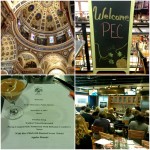Tip: Terms of Engagement
Many speakers and presenters struggle with event attendee involvement. They have great
intentions, but sometimes the attendees just won’t budge. Here are some “ice breakers” that will
help warm up your guests to the idea of participation…
15 Second Sound Off – In a small group setting and armed with a prepared list of topics such as football, cooking, music, etc. choose one person to begin. The chosen person speaks for 15 seconds on the chosen topic and wherever they leave off, the next person in line has to pick up the subject and continue. Each person earns a point for continuing the subject in a meaningful manner without hesitation.
Could it be true? – Guests are asked to tell something about themselves that is either 100% true or 100% false. Others must guess whether that person is telling the truth.
At Attention – Ask everyone to come into the room and find a place to stand. After everyone is settled, let them know that they can take their seat as soon as they have shared their name and something funny that has happened to them with the others in the group (of course, one at a time).
Circle of Friends – Have everyone form two circles, one inside the other. Now have the circle on the inside face the circle on the outside and vice-versa. Ask each participant to introduce themselves, tell the other what they do, where they are from and shake the other’s hand. After each guest has spoken, the inside circle will rotate one to the right. Do this until the entire group has met each other.
You Decide – Once everyone has taken their seats, ask everyone to write down on a piece of paper two things they want to know about a specific topic before they leave the meeting. Structure your discussion and presentation around all of the feedback
Let’s Get on the Same Page – Give each member of the group a sheet of paper identical in size. Explain that they are to follow instructions precisely, and that they are not allowed to ask questions. AND, they are to follow the instructions with their eyes closed. State the instructions:
- Fold the paper in half
- Rip off a corner
- Fold in half again
- Rip off a corner
- Fold again
- Rip off a corner
Have them open their eyes and compare their “design” with others. The point to this experiment is that one-way communication is never as effective as two-way; it gives different results.
This post was written by Cheryl McShane, CMP, President of PEC. You can find Cheryl on Linkedin here.







